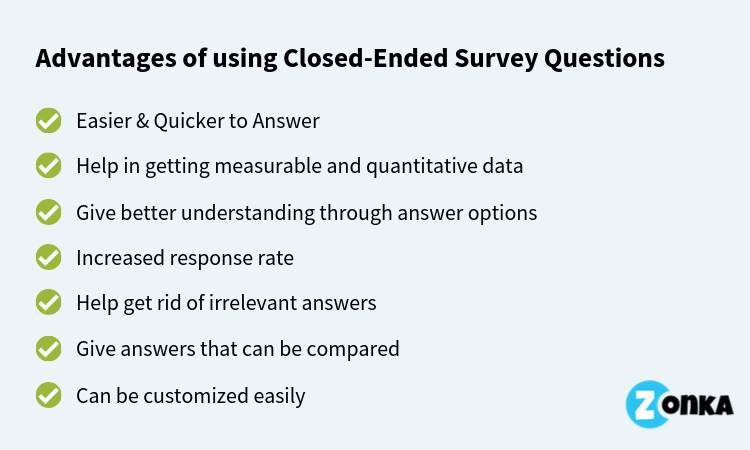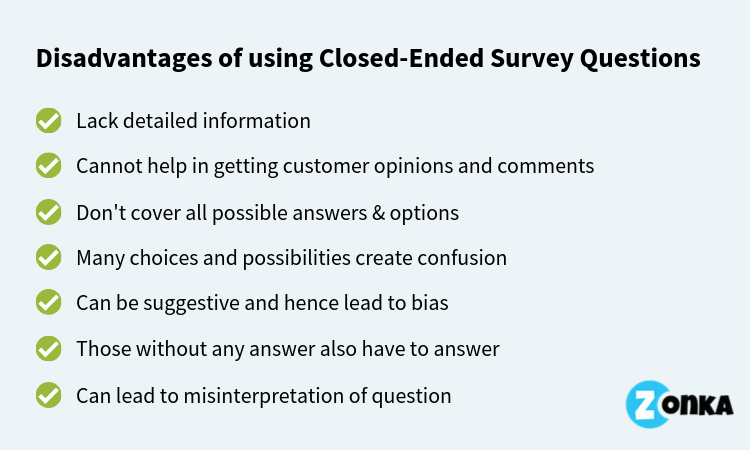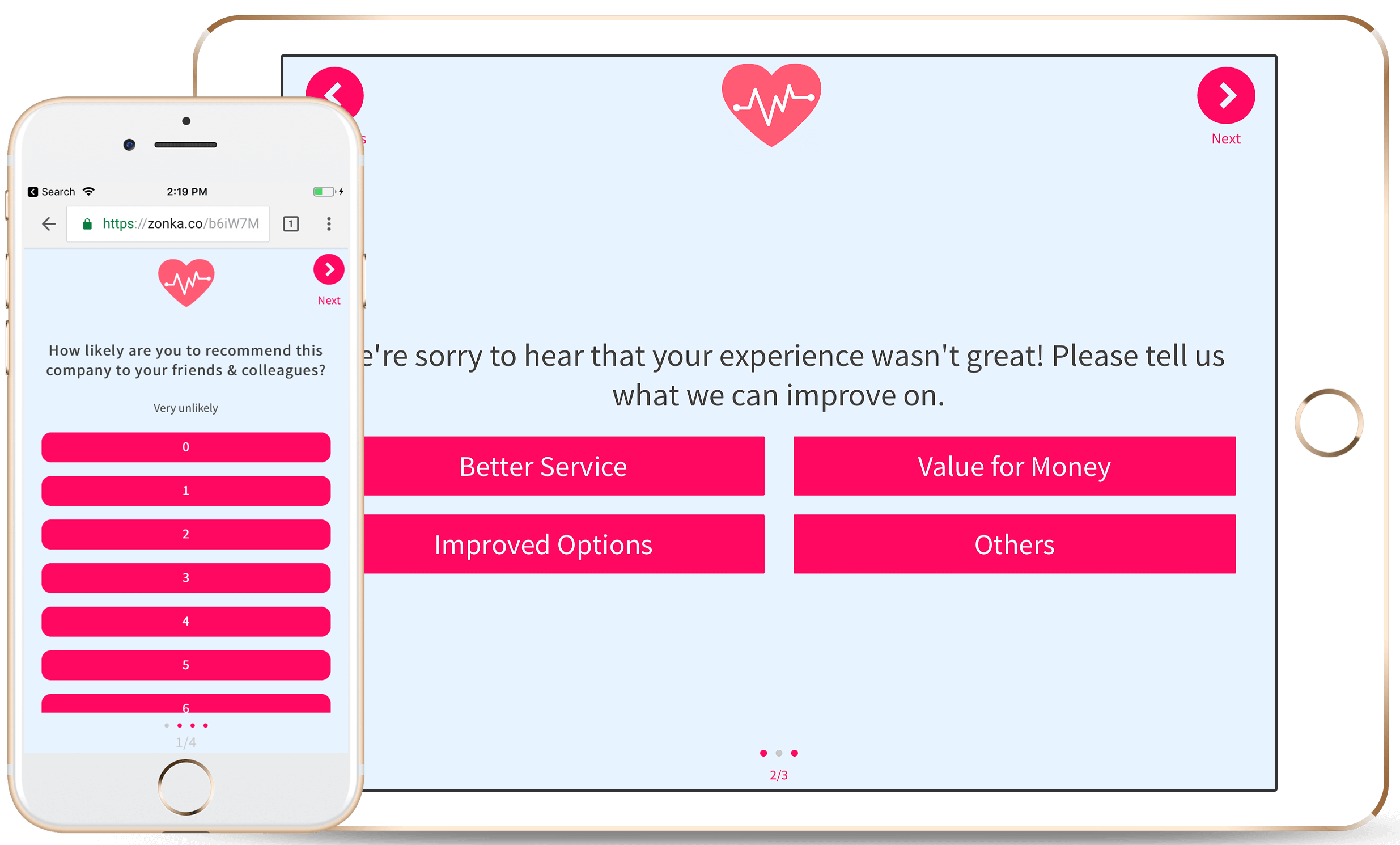Closed-Ended Questions
A closed-ended question refers to a question which provides the customers some predefined choices of answers to choose from which may be in the form of options like Yes or No, ratings from 0 to 10, opinions from Strongly Agree to Strongly Disagree or a range of options depending upon the context of the question. Basically, the customer is not free to write his opinion in his own words and can choose one or multiple options among the provided choices.
When designing a survey, you can choose different types of survey questions. You can choose to ask closed-ended questions or open-ended questions. Both have their but have their own pros and cons.
Advantages of Closed-Ended Questions
There are many advantages of using closed-ended questions in your surveys, especially when you desire to receive a high response rate from your busy customers. Let’s review them here.

- Easier and quicker to answer
Closed-ended questions can be answered easily without consuming much of time as the customers just need to select one of the available answer options. They don’t need to think much and write the answers in their own words. - Help in obtaining measurable and quantitative data
Closed-ended questions are perfect when you need to have quantitative statistics because there will be a fixed number of answer options and you can easily ascertain the number of people selecting each option. - Better understanding through answer options
At times, some customers do not fully understand the question but when they look at the available options of answers, they get clarity of what is being asked. - Customers are more likely to respond
Due to paucity of time, people nowadays avoid filling time-consuming feedback forms, but when they are provided with answer options to choose from, they usually fill the form which helps in having a better response rate. - Help to get rid of irrelevant answers
When open-ended questions are asked, the chances of irrelevant answers increase which makes it difficult for you to gather and analyze feedback data. On the other hand, closed-ended questions have predefined relevant answers to choose from. - Comparable answers
The answers to these questions are easy to compare because only predefined answer options are available for the customers to choose from. You can easily compare the response of various demographic groups with each other. - Can be customized easily
Closed-ended questions are easy to replicate and modify as per the requirement. They can be customized on the basis of the type of survey, type of organization, type of products and services it provides and response required etc.
Disadvantages of Closed-Ended Questions
While there are plenty of advantages, there are also some drawbacks to using close-ended questions. Let’s review them here.

- Unable to provide detailed information
With the help of closed-ended questions, you can get to know the ratings of the customer experience but not the details of it. Even if you give options regarding the reason for the rating, the customer cannot actually tell his full experience and why he rated low/high. - Cannot help to receive customer opinions
Closed-ended questions cannot provide you the information regarding what exactly the customer thinks and feels about your organization and the products/services. This hampers you from getting real customer insight. - It is not possible to cover all possible answers
Every customer is different and has his own unique view. Even after trying your best to cover all possible answer in the options, there are high chances that the answer desired by the customer is not available there. In such a situation, customers can get irritated and leave the survey in between or may choose a similar answer. - More choices can create more confusion
Sometimes, there are so many choices for the customers to answer that he gets confused about what to answer. - Can suggest answers which the customer may not be thinking
There may be a case where a customer would not be even thinking about a particular aspect or idea, but the options in the closed-ended questions make him think in a completely different way. - Customers having no opinion will also answer
It may be possible that a customer doesn’t have any opinion or knowledge about a particular aspect but just to complete the survey and give feedback, he chooses one of the available answer options. This can give you false information and irrelevant customer feedback data. - Not possible to find out if the question is misinterpreted
If a customer misinterprets a question and answers accordingly, it would not be possible to ascertain that he has misunderstood unlike in open-ended questions where you can have an idea about the misinterpretation of a question by reading the answer from the customer.
All you need to do is carefully draft your feedback form selecting a number of closed-ended and open-ended questions or a combination of both.
With Zonka Feedback, you can fully customize your feedback form using an online survey builder and choose from over 30+ feedback question types.





 iPad Surveys
iPad Surveys Android Surveys
Android Surveys Kiosk Surveys
Kiosk Surveys Mobile Forms
Mobile Forms Email Surveys
Email Surveys SMS Surveys
SMS Surveys Website Surveys
Website Surveys Creating Surveys
Creating Surveys Multilingual Surveys
Multilingual Surveys Collecting Feedback
Collecting Feedback Closing Feedback Loop
Closing Feedback Loop Reporting & Analytics
Reporting & Analytics NPS Dashboard & Reporting
NPS Dashboard & Reporting Multiple Locations & Chains
Multiple Locations & Chains Offline Device Tracking
Offline Device Tracking APIs, Webhooks & Integrations
APIs, Webhooks & Integrations Healthcare
Healthcare Education
Education Retail
Retail Financial
Financial Restaurants
Restaurants Hotels
Hotels Customer Satisfaction
Customer Satisfaction Patient Satisfaction
Patient Satisfaction Employee Satisfaction
Employee Satisfaction Net Promoter Score
Net Promoter Score Website Surveys
Website Surveys Feedback Form Templates
Feedback Form Templates Integrations
Integrations The Ultimate NPS Guide
The Ultimate NPS Guide Survey Tips and Tricks
Survey Tips and Tricks Blog and Insights
Blog and Insights Survey Guides
Survey Guides Help Documentation
Help Documentation Customers
Customers


.png)

%20(1).jpg)
.jpg)

.jpg)


.jpg)

















